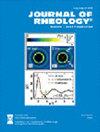共连续聚合物共混物的粒度稳定性
IF 3.2
2区 工程技术
Q2 MECHANICS
引用次数: 0
摘要
聚合物共混纳米复合材料的性能通常与聚合物共混体系中纳米颗粒的时空分布有关。在这里,我们进行了原位高温共聚焦流变学研究,以评估颗粒尺寸对颗粒团聚、颗粒迁移程度的影响,以及随后它们对填充原始二氧化硅颗粒的聚合物共混物的粗化动力学的影响。我们研究了共连续聚丙烯-聚(乙烯-醋酸乙烯)共混物,共混物填充了五种不同的二氧化硅颗粒,直径从5到490纳米不等。当颗粒在热力学上被驱动到它们首选的聚合物相时,颗粒大小不起作用,当颗粒在动力学上被捕获在界面上时,就会产生惊人的效果。我们发现粒子间的相互作用主要是由大小依赖的远程斥力驱动的,这决定了它们的团聚程度,严重影响了它们稳定共连续形态的能力。引人注目的是,最大的(490 nm)颗粒比5 nm颗粒更有效地抑制粗化,而140和250 nm颗粒被发现是最有效的。我们证明了熔体混合过程中界面折叠的相互作用和施加在界面上的拉普拉斯压力对两种大小的初级颗粒的动力学捕获都有影响。这些结果扩展了我们对聚合物共混物中共连续形态稳定的基本理解。本文章由计算机程序翻译,如有差异,请以英文原文为准。
Particle-size dependent stability of co-continuous polymer blends
The properties of polymer blend nanocomposites are typically associated with spatiotemporal distribution of nanoparticles within a polymer blend system. Here, we present in situ high-temperature confocal rheology studies to assess the effect of particle size on the extent of particle agglomeration, particle migration, and subsequently their influence on the coarsening dynamics of polymer blends filled with pristine silica particles. We investigate co-continuous polypropylene-poly(ethylene-co-vinyl acetate) blends filled with five different silica particles with a diameter ranging from 5 to 490 nm. While particle size does not play a role when particles are thermodynamically driven to their preferred polymer phase, a striking effect is achieved when particles are kinetically trapped at the interface. We find that the interparticle interaction largely driven by size dependent long-range repulsive forces governs their extent of agglomeration, severely affecting their ability to stabilize co-continuous morphology. Strikingly, the largest (490 nm) particles are more effective in suppressing coarsening than 5 nm particles, while 140 and 250 nm particles are found to be the most effective. We demonstrate that kinetic trapping of primary particles of either size is influenced by the interplay of interfacial folding during melt blending and Laplacian pressure exerted at the interface. These results extend our fundamental understanding of the stabilization of co-continuous morphology in polymer blends by particles.
求助全文
通过发布文献求助,成功后即可免费获取论文全文。
去求助
来源期刊

Journal of Rheology
物理-力学
CiteScore
6.60
自引率
12.10%
发文量
100
审稿时长
1 months
期刊介绍:
The Journal of Rheology, formerly the Transactions of The Society of Rheology, is published six times per year by The Society of Rheology, a member society of the American Institute of Physics, through AIP Publishing. It provides in-depth interdisciplinary coverage of theoretical and experimental issues drawn from industry and academia. The Journal of Rheology is published for professionals and students in chemistry, physics, engineering, material science, and mathematics.
 求助内容:
求助内容: 应助结果提醒方式:
应助结果提醒方式:


